SUBFAMILY MYRMICINAE - Genus Calyptomyrmex
| The Ants of
Africa SUBFAMILY MYRMICINAE - Genus Calyptomyrmex |
|
| Contents - Myrmicinae - MYRMICINAE Introduction |
In Tribe STENAMMINI.
Diagnostic Features - Median portion of clypeus vertical, projecting anterodorsally as a bilobed structure overhanging the mandibles. Antennae 11- or 12-segmented with a 3-segmented club. Antennal scrobes, above the eyes and very deep, able to contain the whole antenna. Dorsum of alitrunk without sutures, promesonotum convex in profile, the propodeum sloping and armed with a pair of spines or teeth. Dorsal surfaces usually with spatulate or other bizarre hairs.
Emery's (1887b) genus definition is at ![]() (figures unavailable). Type species C. beccarii,
type location New Guinea. Arnold (1917) gave a translation, this is at
(figures unavailable). Type species C. beccarii,
type location New Guinea. Arnold (1917) gave a translation, this is at ![]() .
.
Described by Bolton (1973a) as cryptic species, usually
nesting in very rotten wood deeply embedded in the ground, and foraging
in soil cover. Extensively revised by Bolton, with 16 species known
from Africa (1981a, 1995). The full original text of the first can be
found at -
Bolton,
B. 1981. A revision of the ant genera Meranoplus
F. Smith, Dicroaspis Emery and Calyptomyrmex
Emery (Hymenoptera: Formicidae) in the Ethiopian zoogeographical
region. Bull.
Brit. Mus. (Nat. Hist.) Entomol. 42:
43-81. View or download entire file (4.5M) ![]() .
.
Key to species (developed from that of Bolton (1981a)
| 1 |  First segment of gaster with
stellate, squamous hairs First segment of gaster with
stellate, squamous hairs |
. |
| . |  |
Gabon - stellatus |
| -- | First segment of gaster with variously shaped hairs but never stellate | 2 |
| 2 | 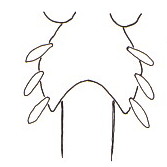 Most forward pair of hairs
on the outer margin of the clypeus stout contrasting with the pair of
fine hairs projecting from the anterior margin Most forward pair of hairs
on the outer margin of the clypeus stout contrasting with the pair of
fine hairs projecting from the anterior margin |
3 |
| -- |  Most forward pair of hairs
on the outer margin of the clypeus elongate and fine matching the pair
of fine hairs projecting from the anterior margin Most forward pair of hairs
on the outer margin of the clypeus elongate and fine matching the pair
of fine hairs projecting from the anterior margin |
6 |
| 3 | 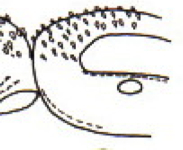 Maximum diameter of
eye much
greater than the maximum width of the hairs in the anterior transverse
row on the pronotum Maximum diameter of
eye much
greater than the maximum width of the hairs in the anterior transverse
row on the pronotum |
4 |
| -- | 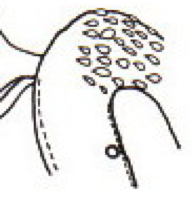 Maximum diameter of
eye at
the most equal to the maximum width of the hairs in the anterior
transverse row on the pronotum Maximum diameter of
eye at
the most equal to the maximum width of the hairs in the anterior
transverse row on the pronotum |
5 |
| 4 |  First
gastral tergite with
short, scattered, scale-like hairs; TL 2.5-2.7 mm First
gastral tergite with
short, scattered, scale-like hairs; TL 2.5-2.7 mm |
. |
| . |  . . |
Zimbabwe - arnoldi |
| -- | 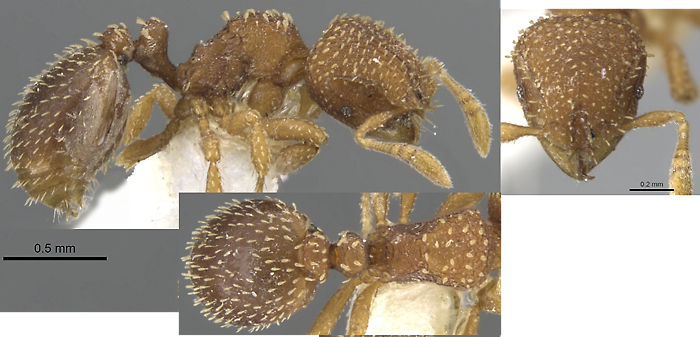 First gastral tergite with
elongate, dense, spatulate, long-stemmed hairs; TL 2.5 mm First gastral tergite with
elongate, dense, spatulate, long-stemmed hairs; TL 2.5 mm |
Uganda & Kenya - tensus |
| 5 | 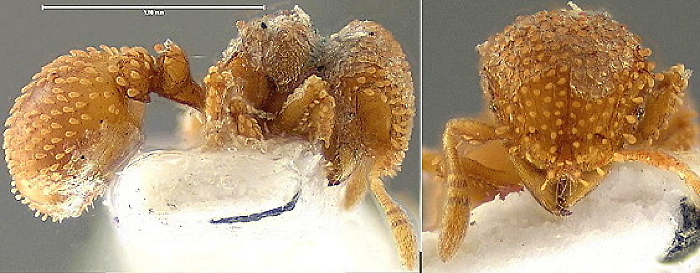 Eyes with 5-6
facets,
maximum diameter ca 0.04 mm; TL 2.5-2.6 mm Eyes with 5-6
facets,
maximum diameter ca 0.04 mm; TL 2.5-2.6 mm |
Forest from Sudan west to Ghana - brevis |
| -- | 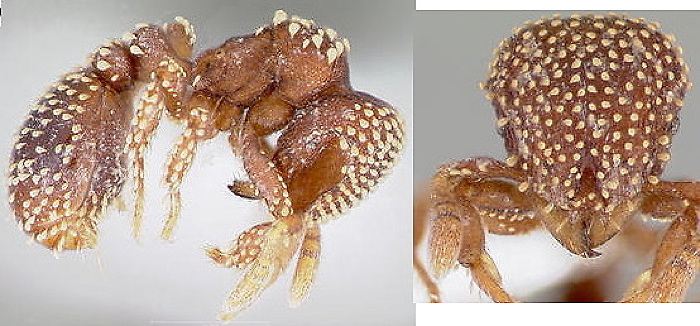 Eyes with > 6
facets,
maximum diameter ca 0.06-0.08 mm; TL 2.8-3.1 mm Eyes with > 6
facets,
maximum diameter ca 0.06-0.08 mm; TL 2.8-3.1 mm |
Widespread (mainly eastern) from Sudan southwards - piripilis |
| Most forward pair of hairs on the outer margin of the clypeus elongate and fine matching the pair of fine hairs projecting from the anterior margin | . | |
| 6 | 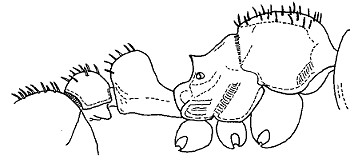 First gastral tergite with
only simple, stout, erect hairs, with acute apices; TL 3.9-4.3 mm First gastral tergite with
only simple, stout, erect hairs, with acute apices; TL 3.9-4.3 mm |
. |
| . | 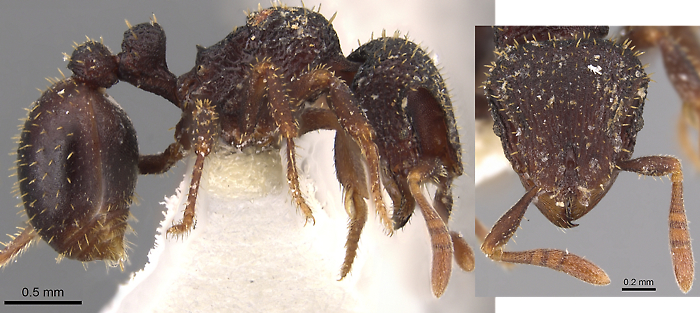 . . |
West Africa & Congo Basin (Gabon) - barak |
| -- | First gastral tergite with scale-like, spatulate or clavate hairs | 7 |
| 7 |  Maximum
diameter of eye at the most equal to the maximum width of the hairs in
the anterior transverse row on the pronotum; TL 2.4-2.8 mm Maximum
diameter of eye at the most equal to the maximum width of the hairs in
the anterior transverse row on the pronotum; TL 2.4-2.8 mm |
West Africa, Congo Basin & Angola - kaurus |
| -- | Maximum diameter of eye much greater than the maximum width of the hairs in the anterior transverse row on the pronotum | 8 |
| 8 | 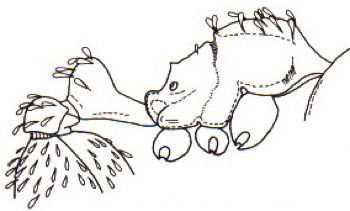 Whole of first
gastral
tergite with bizarre hairs; TL 3.3-3.5 mm Whole of first
gastral
tergite with bizarre hairs; TL 3.3-3.5 mm |
. |
| . | 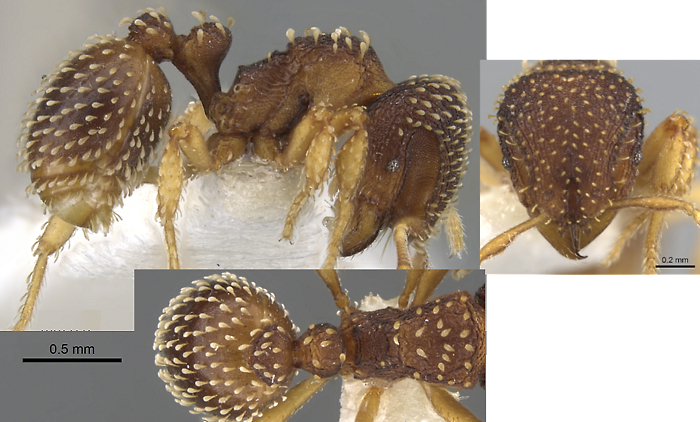 |
East Africa - shasu |
| -- | Only base of first gastral tergite with bizarre hairs, or no such hairs | 9 |
| 9 | 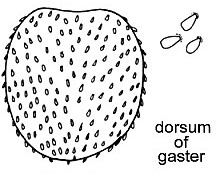 First gastral tergite with
essentially ovoid to teardrop shaped hairs First gastral tergite with
essentially ovoid to teardrop shaped hairs |
10 |
| -- | 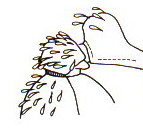  First gastral tergite with
more elongate hairs, with a longer basal stem First gastral tergite with
more elongate hairs, with a longer basal stem |
12 |
| 10 |  Large species, TL
3.0-3.7
mm; with abundant large squamate hairs; mandibles longitudinally
striate, usually very distinct Large species, TL
3.0-3.7
mm; with abundant large squamate hairs; mandibles longitudinally
striate, usually very distinct |
. |
| . |  |
West Africa & Congo Basin - nummuliticus |
| -- |  Smaller species, TL no more
than 3.0 mm; with small squamate hairs; mandibles smooth or faintly
marked Smaller species, TL no more
than 3.0 mm; with small squamate hairs; mandibles smooth or faintly
marked |
11 |
| 11 |  Dorsum of
head predominantly longitudinally rugose, with a reticulum on the
occiput but without a transversely rugulose triangular area on the
vertex; TL 2.6-2.7 mm Dorsum of
head predominantly longitudinally rugose, with a reticulum on the
occiput but without a transversely rugulose triangular area on the
vertex; TL 2.6-2.7 mm |
Zimbabwe - nedjem |
| -- |  Dorsum of head with
longitudinally rugae that diverge towards the occipital corners and
enclose a triangular and transversely rugulose area of the vertex Dorsum of head with
longitudinally rugae that diverge towards the occipital corners and
enclose a triangular and transversely rugulose area of the vertex |
. |
| . |  |
Ethiopia, Gabon, South Africa - foreli |
| 12 | 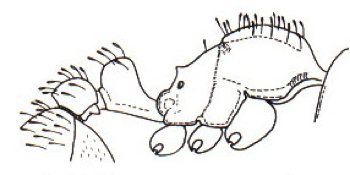 Clypeus with hairs
behind
the outer apical pair also fine; first gastral tergite with long
slender clavate hairs, longer than maximum diameter of the eye; TL
2.8-3.0 mm Clypeus with hairs
behind
the outer apical pair also fine; first gastral tergite with long
slender clavate hairs, longer than maximum diameter of the eye; TL
2.8-3.0 mm |
. |
| . | 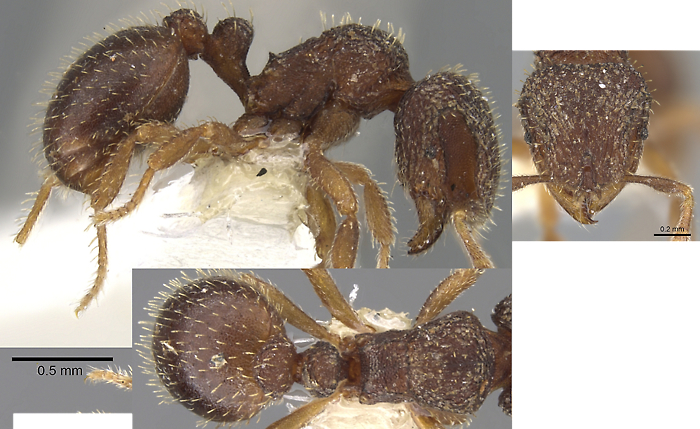 . . |
Zaïre - rennefer |
| -- | 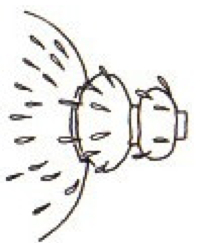 Clypeus with hairs behind the
outer apical pair much stouter and very different in appearance; first
gastral tergite with stout clavate hairs, not or barely longer than
maximum diameter of the eye Clypeus with hairs behind the
outer apical pair much stouter and very different in appearance; first
gastral tergite with stout clavate hairs, not or barely longer than
maximum diameter of the eye |
13 |
| 13 |  Propodeal dorsum
strongly
transversely rugose; without reticulate sculpture; TL 3.2-3.6 mm Propodeal dorsum
strongly
transversely rugose; without reticulate sculpture; TL 3.2-3.6 mm |
Kenya, Uganda, Zaïre - duhun |
| Propodeal dorsum reticulo-punctate, with no more than one or two feeble rugulae; TL no more than 2.9 mm | 14 | |
| 14 |  In dorsal view
postpetiole
distinctly wider than petiole; eyes smaller with 15 or fewer ommatidia In dorsal view
postpetiole
distinctly wider than petiole; eyes smaller with 15 or fewer ommatidia |
15 |
| -- | 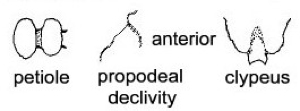 In
dorsal view petiole and postpetiole of similar widths (the postpetiole
however being distinctly wider); eyes with 18 plus ommatidia; TL
2.7-2.9 mm In
dorsal view petiole and postpetiole of similar widths (the postpetiole
however being distinctly wider); eyes with 18 plus ommatidia; TL
2.7-2.9 mm |
. |
| . |  |
Ethiopia, Kenya, Zaïre - clavatus |
| 15 | Clypeal fork with long prongs, outer edges of which are near straight; TL 2.6-2.7 mm | Zimbabwe & South Africa - brunneus |
| -- | 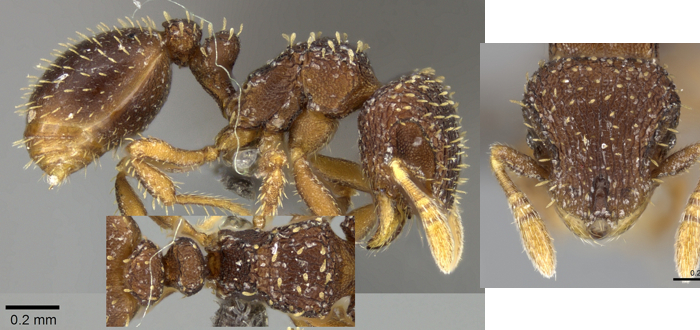 Clypeal fork with short stout
prongs, outer edges of which are strongly bowed; TL 2.1-2.6 mm Clypeal fork with short stout
prongs, outer edges of which are strongly bowed; TL 2.1-2.6 mm |
South Africa - clavisetus |
| MYRMICINAE Introduction |
© 2007, 2009, 2014 - Brian
Taylor CBiol FSB FRES 11, Grazingfield, Wilford, Nottingham, NG11 7FN, U.K. |
href="calyptomyrmex.htm"